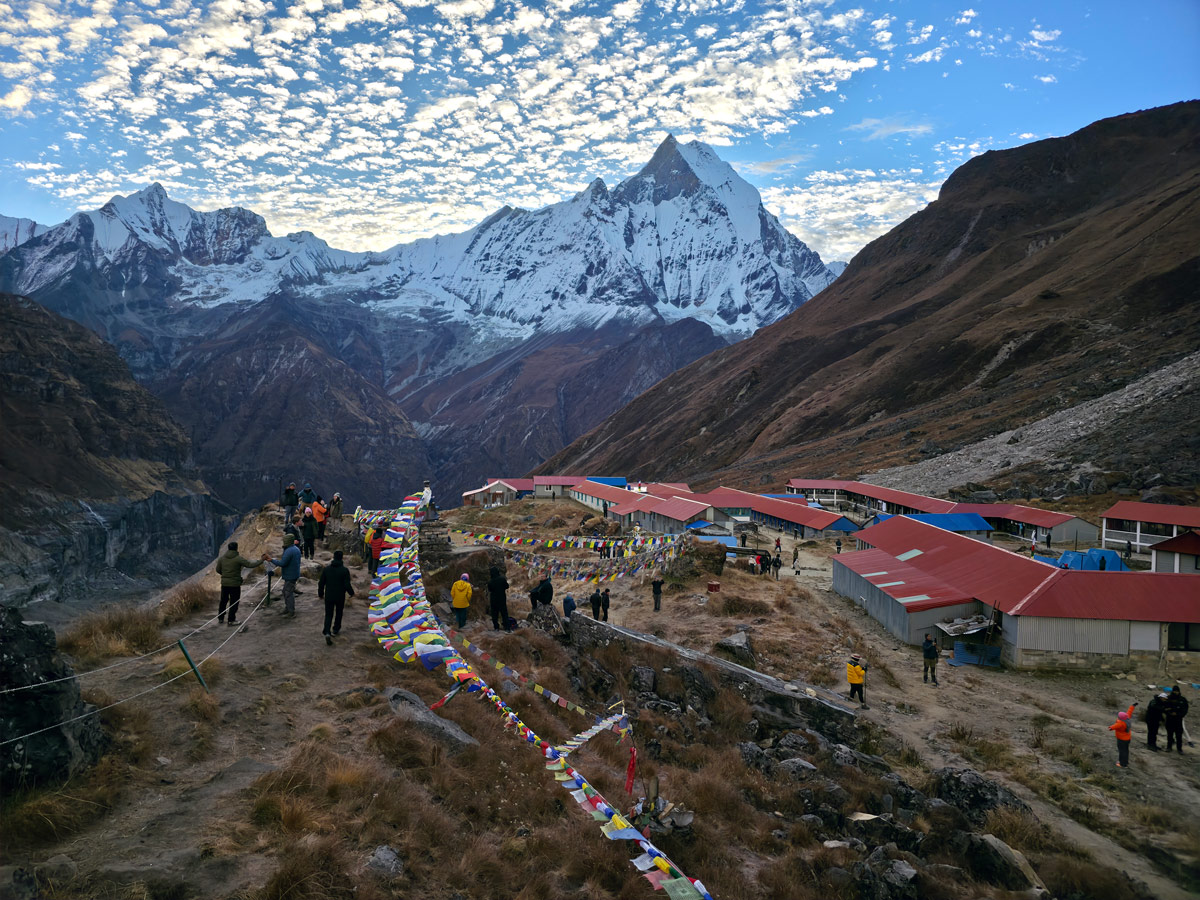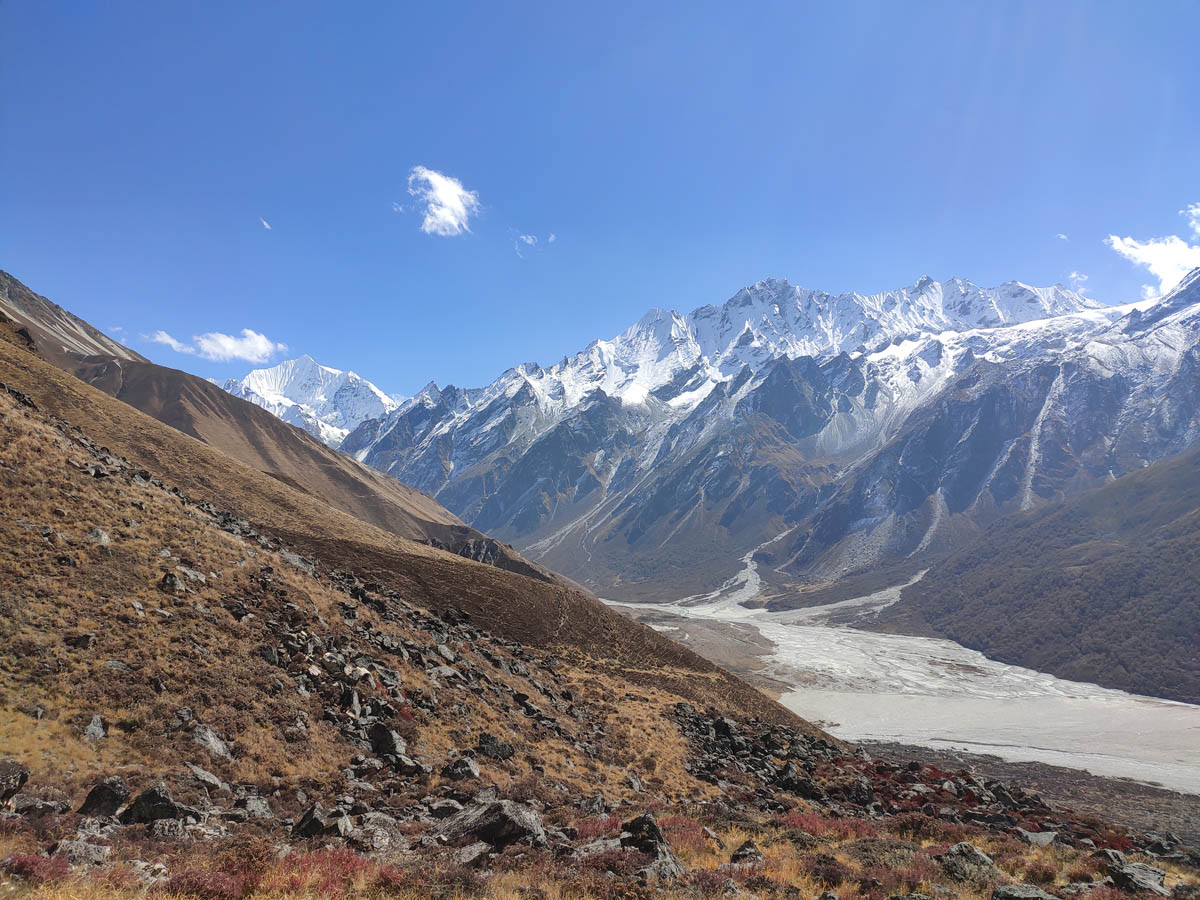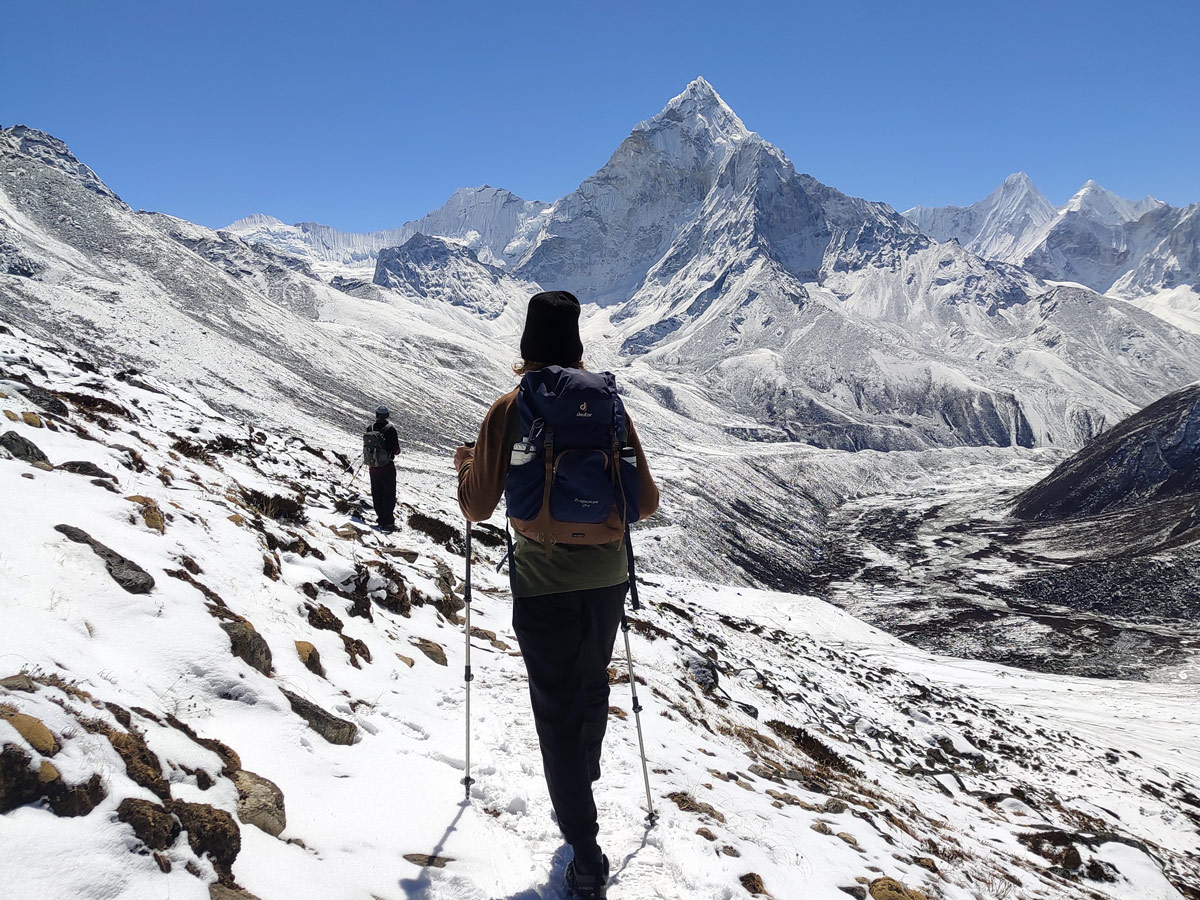Standing on top of a peak blanketed in snow while you take in the majestic view of the surrounding peaks, lush valleys, and icy glaciers around you is an experience unlike any other.
With the promise of the same allure, the Himalayas of Nepal beckon adventure enthusiasts from all over the world. However, there are many aspects to mountaineering which determine the success of your expedition.
Therefore, in this blog we have compiled the necessary aspects like best season to climb, necessary gear and permits, and other preparation tips, making it a one-stop shop for everything you need to know about mountaineering in Nepal.
Overview of Mountaineering in Nepal
When it comes to mountaineering, many peaks throughout the world are open for exploration ranging from Kilimanjaro in Africa to the Andes range in South America. So, what is it that makes mountaineering in Nepal so special?
Well, it is because when it comes to mountaineering, Nepal is not just a next destination, but it is the undisputed King. With the history of mountaineering in Nepal dating back to 1949, the country has ever since beckoned adventurers from all over the world.
Nepal not just has a diversity of options suitable for adventurers of all the levels of experience, it is also home to eight of the fourteen 8000-ers across the world where the climbers can experience the ultimate challenge.
These include Mount Everest (8,848.86 m), Kanchenjunga (8,586 m), Lhotse (8,516 m), Makalu (8,485 m), Cho Oyu (8,188 m), Dhaulagiri (8,167 m), Manaslu (8,163 m), and Annapurna I (8,091 m).
Beyond these giants, Nepal offers over 400 other peaks officially open for climbing, ranging from beginner-friendly trekking peaks to technical alpine routes.
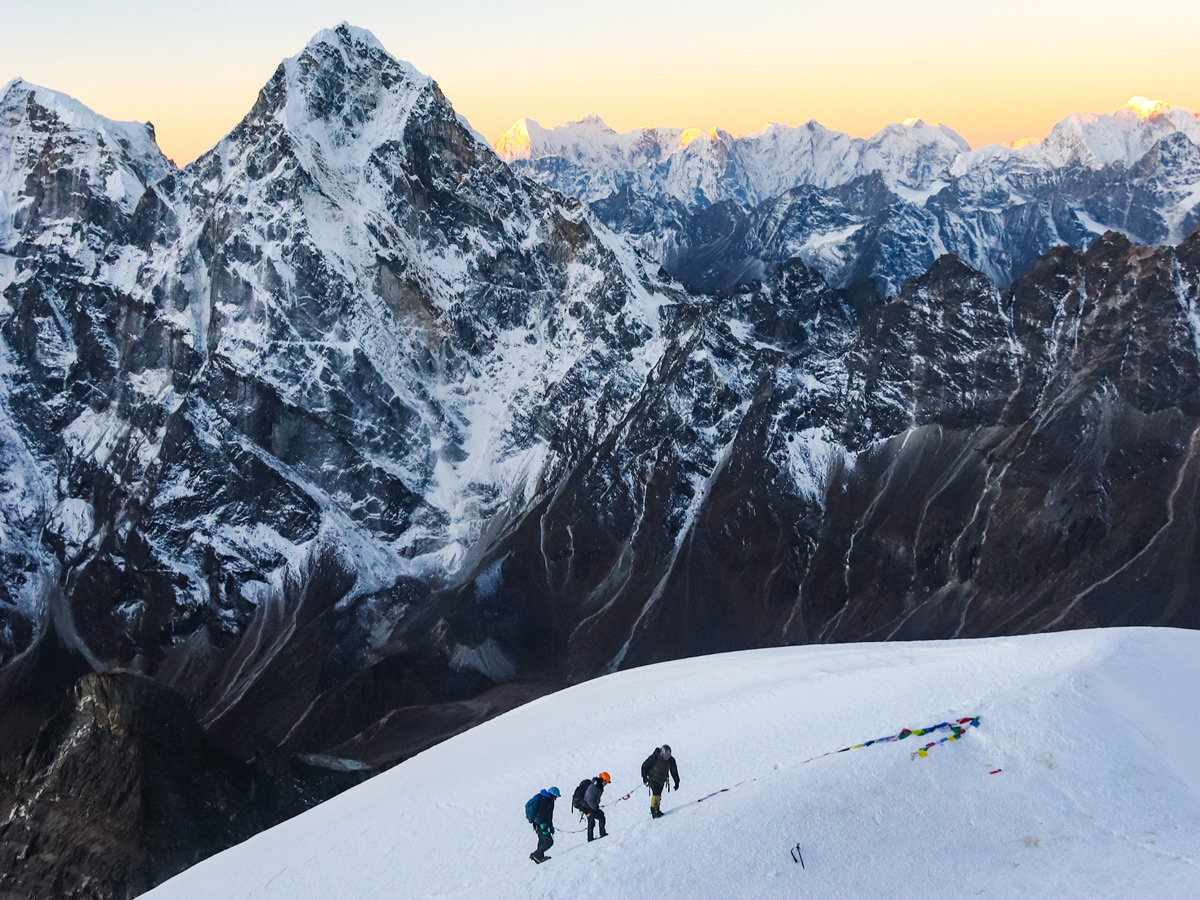
Popular mid-range climbs include Island Peak (Imja Tse, 6,189 m), Mera Peak (6,476 m), Lobuche East (6,119 m), and Chulu West (6,419 m). More experienced climbers often attempt Ama Dablam (6,812 m) for its iconic pyramid shape, or Baruntse (7,129 m) and Himlung (7,126 m) for higher-altitude challenges.
From the mighty Mt. Everest to the stunning Annapurna range, you will come across a stunning display of the crown jewels of the country, i.e. the Himalayas. The best part is, mountaineering in Nepal is way beyond just the climb.
While in Nepal, you will be treated to a diversity of cultures and ethnic groups each with their own traditions, languages, festivals, costumes, and even religious places. Along with that, you are also treated to the warm local hospitality.
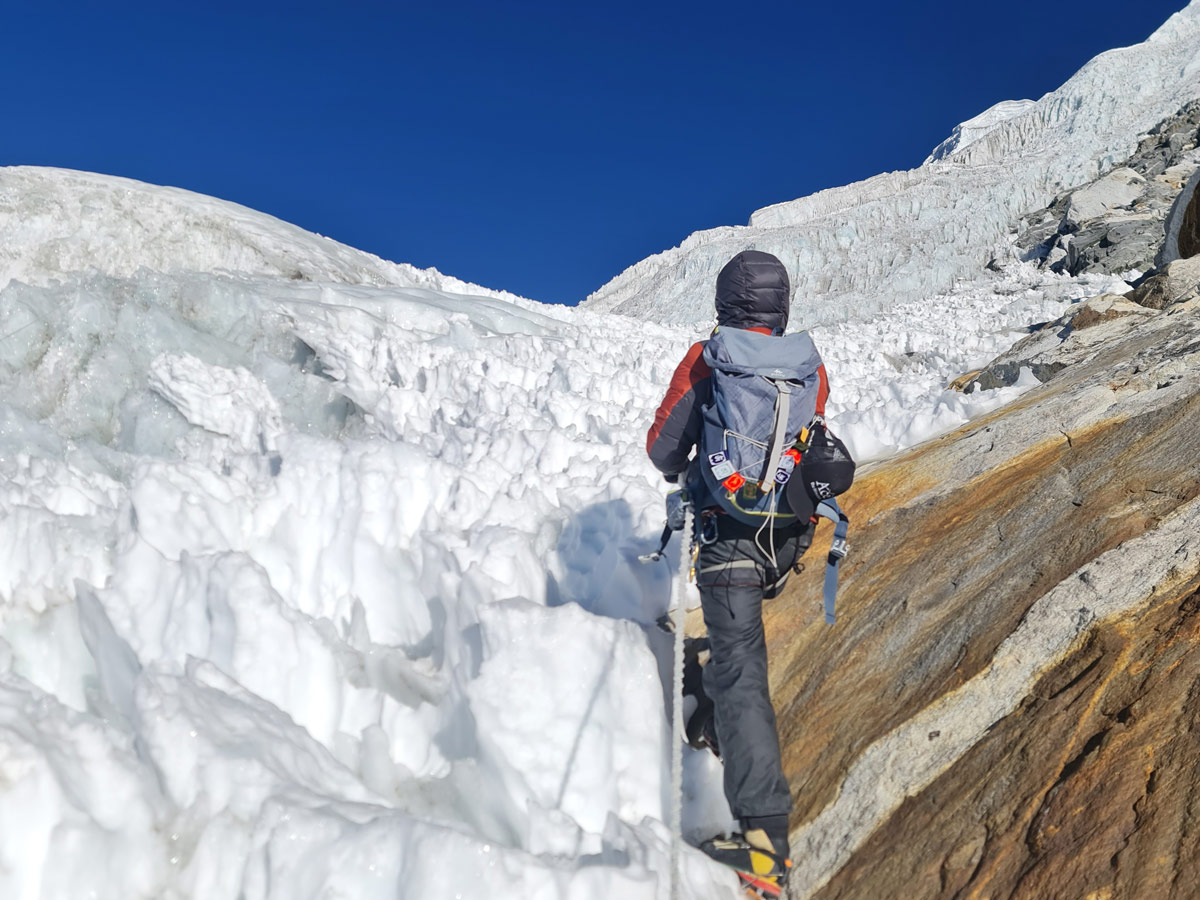
Another reason why Nepal attracts crowds of adventure enthusiasts is due to the established infrastructure with easy availability of guides, well-maintained mountaineering trails, and organizations working for your safety.
Major approach routes such as the Everest Base Camp trail (for Island Peak, Lobuche East, and Ama Dablam), the Annapurna Circuit (for Pisang and Chulu peaks), and the Manaslu Circuit (for Manaslu and Himlung) are well-supported with teahouses, lodges, and rescue posts.
Kathmandu, being the hub for expeditions, houses most of the licensed mountaineering agencies, certified mountain guides, and equipment suppliers.
Planning Your Expedition
A lot of things should be considered before you embark on your mountaineering expeditions. You should meticulously research, take advice from experts like local trekking agencies, and plan accordingly.
Choosing the right peak for your experience level is the first step. Beginners can start with non-technical trekking peaks under 6,500 m such as Island Peak, Mera Peak, or Yala Peak in the Langtang region.
Intermediate climbers might prefer more technical summits like Lobuche East or Chulu West. Advanced mountaineers can take on Ama Dablam, Baruntse, or Manaslu.
Each mountain has unique features, approach routes, and required permits, so understanding these in advance is crucial.
Best Season for Mountaineering in Nepal
The first and foremost thing to know is the best season for your expedition as some seasons might make your experience less rewarding and some might make it much more challenging than usual.
Similar to the best time for trekking in Nepal the months of Spring (March to May) is the most popular season for mountaineering in Nepal. During springs, you will have high visibility giving you fantastic views and clarity during the climb.
Besides that, the climate is also usually stable, and the trail is relatively warmer with active flora and fauna. However, you will encounter crowds during this season as it is the peak trekking season.
Spring is also the main expedition window for 8,000-meter climbs like Everest, Lhotse, and Makalu, as jet stream winds shift north and allow for clearer summit pushes.
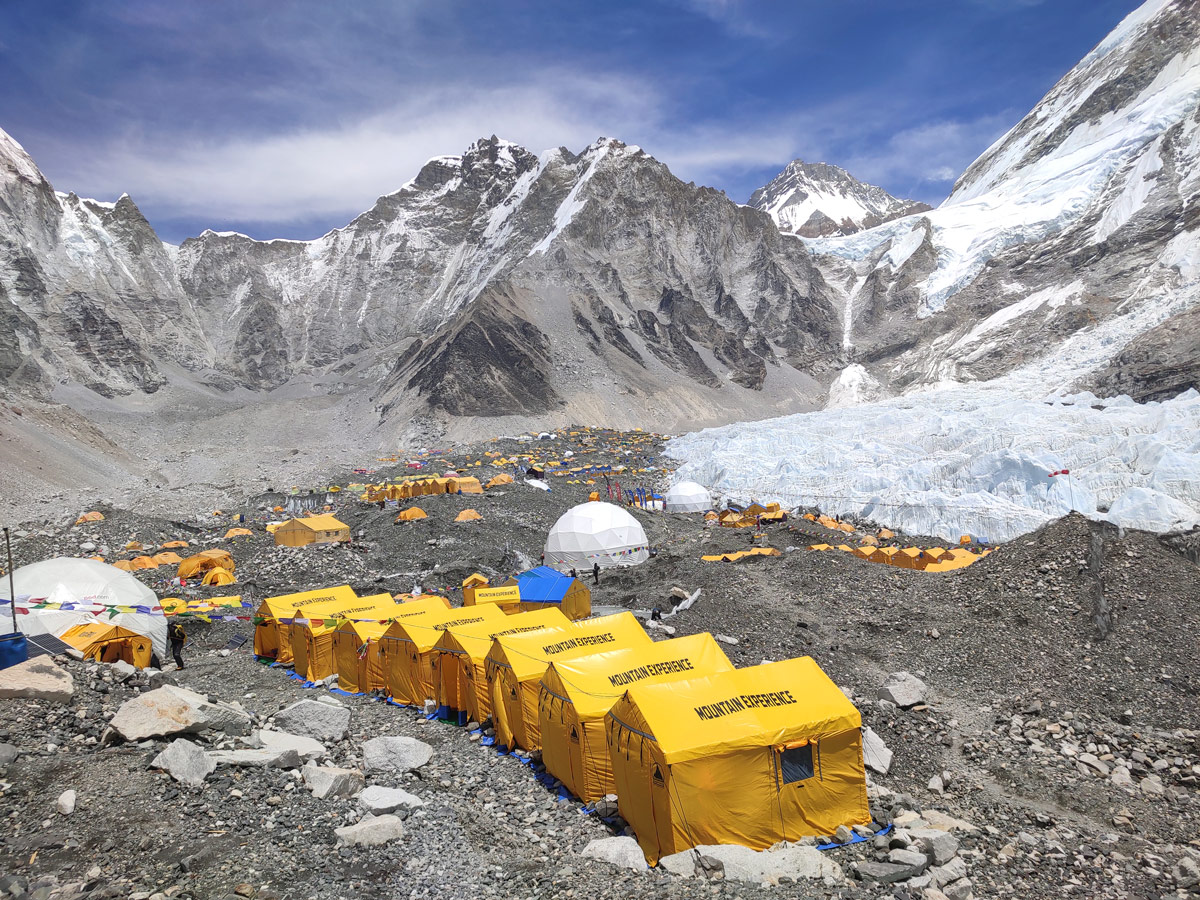
Sherpa teams begin fixing ropes from mid-April, and most expeditions aim for summit bids in early to mid-May. Mera and Island Peaks also see increased activity during this season due to stable snow and ice conditions.
Another good time with slightly less crowds is the months of autumn (September to November) when you will be treated to clear skies and stable weather conditions favorable for climbs.
Autumn provides excellent post-monsoon clarity and steady conditions. Climbers often attempt Ama Dablam, Manaslu, or Himlung during this period since temperatures are moderate and visibility exceptional.

The months of monsoon (June to August) and winter (December to February) are better if avoided as they bring lots of challenges. During monsoon, the trails are treacherous and slippery with high chances of rainfall.
During winter, you are exposed to harsh climatic conditions which might be difficult to bear. There is also an increased risk of avalanche and high risk of injury while walking on icy trails.
Therefore, if you are beginner with less or no experience of mountaineering, it is advisable to opt for either spring or autumn.
Permits and Regulations
It is important to have your documentation in place before reaching the location of the climb. Mountaineering in Nepal required the climbers to carry certain permits based on the peak that you are planning to scale.
First and foremost, you must have a Trekker’s Information Management System (TIMS) card while climbing as you will be mostly going through trekking trails and this permit helps the authorities to keep track of your whereabouts.
If you are planning to climb peaks that are located within the boundaries of restricted areas, i.e. national parks or conservation of Nepal like Mt. Everest, Mt. Annapurna, and more, you need a permit specific to that national park.
Examples include the Sagarmatha National Park Entry Permit (for Everest region), the Annapurna Conservation Area Permit (ACAP) for Annapurna and Pisang peaks, and the Manaslu Conservation Area Permit (MCAP) for Manaslu and Himlung. Each permit can be obtained either in Kathmandu or at the entry checkpoints.
Besides this, for people wanting to scale peaks higher than 6,500 meters, including the 8000-ers and other high-altitude peaks, you will be assigned a liaison officer by the government to ensure that you are adhering to the safety protocols and regulations.
Climbing permits are issued by two main authorities: the Nepal Mountaineering Association (NMA) for peaks below 6,500 m and the Department of Tourism (DoT) for peaks above 6,500 m.
Fees vary: for instance, Mera Peak costs around USD 250 during spring and USD 125 during autumn, while Everest’s climbing permit alone is USD 11,000 per person. The government also requires climbers to carry insurance for both themselves and their support staff (guides and porters).
Physical Fitness
Mountaineering, especially in beginner friendly peaks of Nepal, is an experience similar to high altitude treks as it usually takes you to altitude ranges of 5,400 m to 6,500 meters. This requires a good level of physical fitness.
You should indulge in a rigorous fitness regime at least 3 to 5 months before the expedition and the exercises should be done on a regular basis. Include a combination of all kinds of workouts.
Your main focus should be on building your cardiovascular strength to tackle the altitude along with endurance exercises and strength conditioning. Focus on your core muscles, calves, shoulders, back, and legs to help with the long hours of climbing.
If possible, stimulate conditions matching the actual climb as it helps you to condition your body in realistic conditions and also helps you to altitude train your body for easier acclimatization.
Go for treks on nearby trails with a difference in elevation. If that is not possible, climb and get down the stairs of a tall building regularly.
Activities like running, cycling, swimming, and weight training should be a crucial part of your routine. Also include flexibility exercises and breathing exercises to help with balance and soreness of muscles post the climb.
Climbers can also use altitude simulation masks or train in high-altitude environments to adapt their breathing patterns. It’s advisable to undergo a medical check-up before the expedition to rule out respiratory or cardiovascular issues.
Many climbers do pre-expedition treks, such as the Everest Base Camp Trek or Annapurna Circuit, to condition themselves to high altitude before attempting peaks like Island or Lobuche.
Technical Skills
Mountaineering in Nepal becomes much easier and safer if you learn the basic technical skills. Although you can pick a trail with less technical sections if you lack the technical skills, basics can come in handy in such trails too.
The technical skills in mountaineering are uncountable like belaying, anchoring, rope work, crack climbing, and more. However, the ones that even a beginner must know are rock climbing, ice climbing, crevasse rescue, and the use of crampons.
Knowing the usage of ropes and several ropework techniques can also be a life savior in case of emergencies. Therefore, it is advisable to learn these basic technical skills before you set off on your expedition.
You can learn it before coming to Nepal. Or you can keep some extra time before the expedition and learn these skills from expert climbers at Nepal Mountaineering Association.
Many climbers also take part in a one-week basic mountaineering course offered by institutions like the Nepal Mountaineering Instructors Association (NMIA) or the Himalayan Rescue Association (HRA), which teach rope management, ice axe arrest, crevasse navigation, and use of fixed lines. Such training not only boosts confidence but also fulfills eligibility for higher climbs in the future.
Gear and Equipment
A packing list makes a big difference to your entire expedition journey. You must have all the necessary gear and equipment as you will be traveling to some of the most remote landscapes in the world.
First and foremost, you should have enough clothes, the ones suitable for a layered clothing system are highly recommended. Pack in your warm base layers, insulating layers, as well as your down jackets.
Carry other clothing items like gloves, gaiters, mufflers, scarfs, and woolen caps as you will be exposed to extreme temperatures while at the Himalayas. Also carry outer shells to combat winds, snow, and rainfall too.
A good pair of climbing boots with a good grip and ankle support are important. Also add in gaiters to protect from snow and scree. Micro spikes and ice cleats are suitable and give you a good grip on snow and ice, preventing you from slipping and injuries.
Crampons are a good addition to tackle the technical sections and an ice axe or a shovel might be useful to remove the snow if you come across a trail blockage of any sort depending on the peak.
Climbing equipment like rope, harness, carabiners, helmet, ascenders, rappelling gear, can be a life savior. Also carry a compass for proper navigation in the Himalayas.
Carry a well-equipped first aid box with a wide spectrum antibiotic, painkillers, ointments, bandages, antiseptic wipes, and pain relief spray to help with any minor inconvenience during the trek.
A headlamp and a torch can help you tackle some challenging situations in case of low lighting areas. Also carry high protein snacks like protein bars, nuts, oral rehydration salts to remove palate fatigue and give instant energy.
Not to forget, the camping essentials like high altitude tent and a zero-degree sleeping bag with liners are crucial to protect you from the challenging temperatures of the Himalayas.
For higher expeditions, climbers also carry altimeters, avalanche beacons, satellite phones, and oxygen cylinders. All major equipment can be rented or purchased in Kathmandu’s Thamel or Pokhara’s Lakeside, where top international brands like Black Diamond, Petzl, La Sportiva, and The North Face are readily available. Local gear rental shops offer high-quality expedition gear at affordable daily rates.
Safety and Risk Management
Although well managed and crowded, mountaineering in Nepal is not a walk in the park and contains a lot of risk related to weather, terrains, and your personal health. Therefore, it is crucial to take the necessary precautions to safely complete your journey.
Altitude Sickness
One of the main risks that you will come across during mountaineering is altitude sickness which is caused due to rapid ascent at high altitude. It can cause symptoms like headache, nausea, dizziness, loss of appetite, lack of sleep, and more.
If proper attention is not paid, it can even grow into serious conditions like High Altitude Pulmonary Edema (HAPE) and High Altitude Cerebral Edema (HACE). Therefore, it is important to take proper precautions to prevent altitude sickness.
The key point to follow is proper acclimatization. Dedicate 2 to 3 days from your itinerary to let your body adapt to the high altitude. Ascend slowly and gradually and stay hydrated and maintain a balanced diet. Listen to your body and learn to recognize the symptoms.
Rest days are often planned in places like Namche Bazaar (3,440 m), Dingboche (4,410 m), or Manang (3,519 m) to allow your body to adapt. You can also take preventive medication such as Acetazolamide (Diamox) and carry portable oxygen cylinders for emergencies.
Weather Related Challenges
Another challenge that you might face are the hazards that come with the unpredictable mountain weather. The weather might change from sunny to stormy in a matter of minutes and you will see sudden changes in wind, temperature, and snowfall.
Make sure to carry all the required gear and travel with a guide as they know the routes you can take for safeguarding in case of emergencies. You also need to have a flexible itinerary to accommodate any changes due to bad weather.
Regular updates can be checked via the Department of Hydrology and Meteorology, Nepal, or apps like Windy and Mountain-Forecast. Local guides and base camp staff also receive daily radio briefings about route and weather conditions.
Emergency Preparedness
Situations like avalanche, snowstorms, and landslides are a possibility even in the most well managed mountaineering trails. While the general climatic conditions can be predicted based on the month, these emergencies are beyond prediction.
Therefore, you should always have access to reliable communication systems like a satellite phone or a personal locator beacon along with reliable evacuation plans. Also, make sure to get insurance with helicopter rescue services for such emergencies.
Make sure your insurance explicitly covers climbing above 6,000 m and includes evacuation to Kathmandu.
Additional Tips
- The Himalayas of Nepal are a fragile ecosystem. So, while you explore the natural beauty and might of it, make sure to not leave anything behind that can be a hazard to the ecosystem. Strictly adhere to the ‘leave no trace’ policy.
- Use energy efficient equipment like solar chargers instead of battery-operated things. Opt for biodegradable products.
- Respect the local culture and traditions as you will come across several religious sites in the Himalayas of Nepal throughout your journey.
- Going for a mountaineering expedition in a new country without a guide is a bad idea. You must partner with a reputed local agency like Ace the Himalaya that will assign your experienced climbers as your guides to ensure your safety.
- For many people, mountaineering might not be a usual thing. It might either be a one-time adventure, or you might have a long gap before the second expedition. Therefore, the feasible option is to rent the mountaineering gear rather than purchasing it all. We at Ace the Himalaya also provide you with rental options.
- Doesn’t matter if you are buying your gear or renting it, always opt for branded items as it is a matter of your safety. The trusted brands in the world of mountaineering are Black Diamond, The North Face, Mammut, which you will easily find in shops of Thamel, Kathmandu, or Pokhara.
- Treat your porters respectfully as they are a big part of making your expedition successful. Pay them fair wages and tip them well too as they do the physical labor to help you out in such extreme conditions.
- Finally, remember that each successful expedition is built on teamwork, patience, and respect for the mountains. Whether you’re summiting Island Peak for the first time or attempting Ama Dablam or Manaslu, preparation and humility are key to both safety and success.

